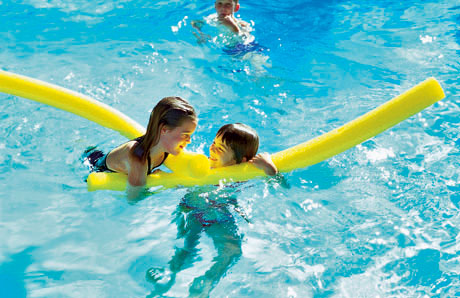How to prevent swimmer's ear when enjoying your pool—5 tips
Swimming may be lots of fun, but getting swimmers ear is not. If you feel itchy inside your ears, have drainage or inflammation in your ear canal, or pain inside your ear when you tug on your earlobe, chances are good you have a case of swimmer’s ear.
The infection impacts the external ear, specifically the skin of the ear canal. When this skin gets wet and stays wet, it softens—becoming a warm inviting spot for germs to grow. Typically the culprit is bacteria, but it can also be fungal.

While the ailment is more common among children, adults get it too. The good news is that with some simple measures, you can slash the risk for you or your children getting swimmer’s ear. Here are five ways to avoid it:
1. Swim in a properly maintained pool.
When swimming pool water is kept in balance, it’s harder for nasty microorganisms to grow. A strong, harsh, bleach-like odor is a sign that the swimming environment is less than ideal. The smell comes from chloramines, a substance that forms when chlorine combines in the water with sweat, urine, body oils, and other organic matter. To ensure a healthy swimming environment in your backyard pool, check the water chemistry—be generous when it comes to using those test strips , adjust the chemical levels as needed. Bonus Tip: Maintaining the pH and alkalinity is much easier if your pool has an ozone system or a saltwater sanitizer.2. Avoid getting water in your ears in the first place.
You can enjoy a pool or spa without ever submerging. However, if you are swimming laps or trying to protect children who like playing in the water, your tactic should be keeping water from ever getting into the ears. Create a barrier with earplugs designed for swimmers. Be sure to get ones that fit well, conforming to the shape of your ear or those of your children. Another option is a snug-fitting swim cap that makes it difficult for water to seep into ears.3. Let earwax do its job.
Our bodies produce ear wax for a reason; the sticky substance lubricates the ear canal, traps particles, and makes it difficult for bacteria and other unwanted microbes from gaining a foothold. This natural barrier is one of the best guards against swimmers ear. So, step away from the cotton swabs! Unless ear wax is building up and creating a blockage, leave your ears alone. If earwax removal is truly needed, do so carefully with a safe method like a few drops of mineral oil or other over-the-counter earwax treatment, or consult a health professional.4. Dry out your ears thoroughly.
Getting rid of any water in your ears after swimming or showering is one of the best ways to prevent swimmer’s ear. A dry ear canal—moist only from natural earwax—leaves little opportunity for an infection to start. To expel trapped water from your ears, tilt your head to one side; tug on your ear lobe and outer ear—doing so will help loosen and straighten the ear canal so the water can more easily escape. To maximize the ear-canal stretch, try reaching around the back of your head with your opposite hand to pull on your outer ear. Another option is to very gently and cautiously wick moisture from the canal using the corner of an ultra-soft tissue.5. Wash out ears with the right solution.
A popular trick among regular swimmers and people prone to ear infections is a simple rinsing of the ears after swimming or showering. The top choice is a few drops of rubbing alcohol, which does double duty by killing germs and helping evaporate any water that may be in the ear canal. A variation is to use one part alcohol and one part white vinegar, which lowers the pH so that the solution is not overly drying for your ears. Whichever mixture you prefer, store it an eyedropper bottle so it’s handy for convenient use.While not full-proof, these strategies can cut the odds for swimmers ear. Using several of them in combination cuts the infection risk even further.




.jpg?width=1490&name=rock-waterfall-slide-pool%20(1).jpg)